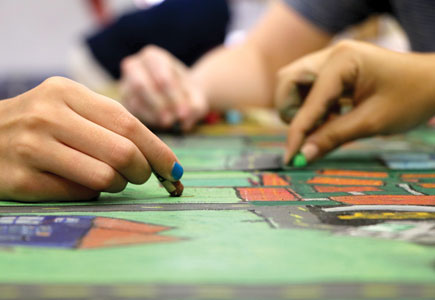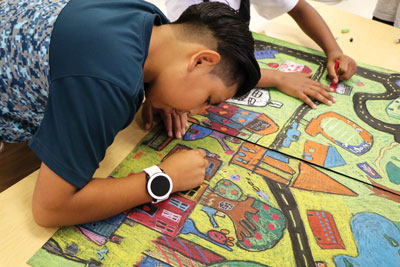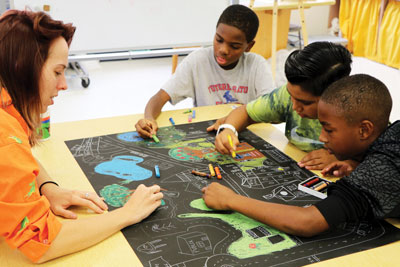Overview
Once a week, university and elementary students met in the art room to create maps of their community, first individually and then in groups. Students initially used drawing pencils to create their own personal maps of Gainesville on 9 x 12" (23 x 30 cm) drawing paper. Once finished, they shared their maps with their groups and discussed ways to incorporate elements of each other’s map into a larger collaborative map. The maps are more conceptual than geographically correct and are meant to show how students think about their community.
Students worked collaboratively on 18 x 24" (46 x 61 cm) sheets of black construction paper to create their group maps. They used white colored pencils to draw the roads and landmarks of their maps and colored them in with oil pastels. While some groupstaped together two large sheets of black paper to work on, other groups were more ambitious and taped four sheets together to create maps approximately 36 x 48" (91 x 122 cm).
What Is a Map?
Simply put, a map is a picture of a place. There can be many different maps of the same place; one map cannot show everything there is to know about a place. For a map to communicate clearly, it must show a limited number of things. Maps are made for different reasons—some are made to show property lines, some show us how to get where we want to go, and others show precipitation in a particular region. The most important function of a map is to show where certain things are in relation to other things.
Mental Maps
In the process of exploring our environments, we construct and reconstruct mental maps that provide a basis for our understanding of the world and where we are within it. The maps we make in our minds incorporate our knowledge and experience of places, accumulated over the years as we make our way through the world. How detailed our mental maps are depends upon the amount and type of information we have about certain places (i.e., firsthand experience, oral history, formal education, social class, and mass media all play a role in shaping our mental maps of the world.)
This project is guided by the notion that we all have mental maps of the places in which we live. These visions are different for each inhabitant of a place. By providing students with the opportunity to draw and share their artistic visions of the communities in which they live, we discover the connections they have formed with their nearby world, the things that are emotionally important to them, and their evolving sense of place.
Steps of the Project
During the first meeting, students looked at examples of maps that were particularly graphical in nature and discussed questions such as: What is a map? What kinds of things might be shown on a map? Afterwards, each participant was asked to draw a map of where they live, however they imagined it.
In the next meeting, students shared their “home maps” and talked about the things that exist around their homes, including places they frequent in their neighborhoods. This dialogue is meant to expand their frame of reference and to introduce the idea of mapping their community. The focus is on how each participant views their community and the kinds of places that seem most important to them.
Next, students drew a map of their community, however they imagined it. This map showed the people, places, and landmarks in their community that are most important to them, and how they get to these places (e.g., using roads or bridges). Once the individual maps were finished, a discussion followed on ways to incorporate elements of each map into a larger collaborative map. These collaborative maps took about four meetings to complete. Upon completion, the group maps were exhibited at a local arts festival, on the University of Florida campus, and in the participating school.
Outcomes
While the results of this project are seen in the maps produced by participants, the real benefits lie in the experience gained during the collaborative process. For the university students, mentoring young artists had a significant impact on their attitudes about art and their roles as aspiring art teachers.
For the younger map artists, the project afforded the opportunity to relate their school activities to their lives outside the classroom as well as to enhance their knowledge of their community. More importantly, through the process of working collaboratively with older students, the younger students learned that their ideas and experiences have value. Such knowledge is empowering.
Craig Roland is professor emeritus of art education at the University of Florida in Gainesville, and a contributing editor to SchoolArts. rolandc@ufl.edu
NATIONAL STANDARD
Connecting: Relating artistic ideas and work with personal me aning and external context.
WEB LINK
Mapmaking with Children: heinemann.com/products/e00042.aspx
View this article in the digital edition.





